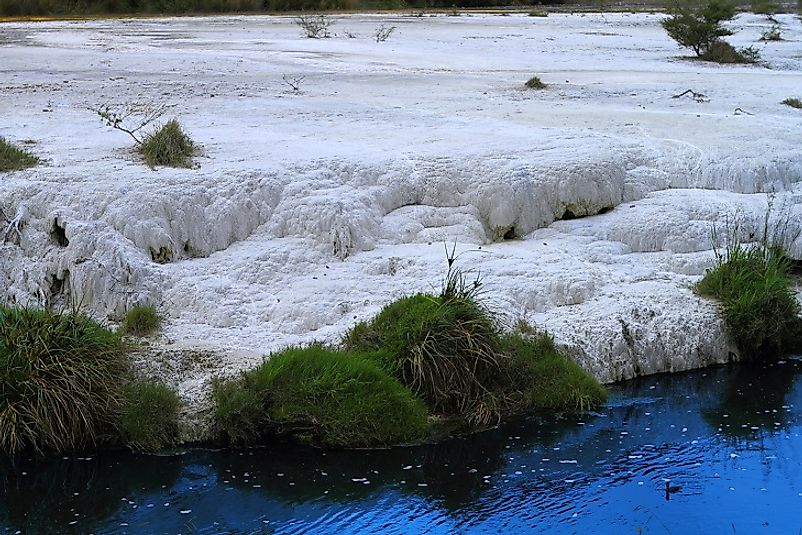The Pink And White Terraces - Geological Marvels Of New Zealand

5. Description
In 1886, a volcanic catastrophe resulted in the loss of one of the most treasured geological wonders of New Zealand the Pink and White terraces of Lake Rotomahana in the Waimangu Volcanic Rift Valley of the North Island of New Zealand. The terraces comprised of silica sinter deposits, the largest known formations of this kind ever known to have existed on our planet. The two deposits were found on opposite shores of Lake Rotomahana. The White Terrace displayed a brilliant white color while the Pink Terrace had a pink tinged landscape, possibly due to the presence of some form of chemical impurity in the silica sinter deposits. Both the terraces formed a spectacular landscape that was described in the accounts of early travelers to this place. Though the terraces were believed to have been lost in the volcanic eruption, as recently as 2011, scientists studying the geological history of Lake Rotomahana have rediscovered a part of the lost landscape under the waters of the lake.
4. Historical Role
Prior to the volcanic eruption that wiped away the Pink and White terraces, the site was one of the most popular tourist attractions in New Zealand. One of the earliest European visitors to the site was Ernst Dieffenbach whose accounts of the place inspired the arrival of future tourists to the spot. Some of the notable men touring the Pink and White Terraces in the 19th Century were Sir George Grey, a British soldier and explorer, Anthony Trollope, an English novelist of the Victorian age, and Alfred Duke of Edinburgh, a member of the English royal household. The situation completely changed on the fateful day of June 10, 1886, when a massive eruption of the Mount Tarawera, located about 10 kilometers away from the Lake Rotomahana, killed nearly 120 indigenous Maori inhabitants and also wiped out the entire landscape feature of the Pink and White Terraces.
3. Tourism and Research
Research that led to the re-discovery of the White and Pink Terraces of Lake Rotomahana was conducted in 2011 when a team of scientists from GNS Science arrived at the site with an aim to map and study the lake bed and understand the geomorphological transformations of the landscape since the eruption of Mount Tarawera. To their surprise, while mapping the bottom of the lake, they found that nearly three-quarters of the Pink terraces and a small section of the White Terraces still remained intact underneath the lake, covered in several layers of mud. This was an exciting and unexpected discovery as it was generally believed that the intensity of the eruption was so high that the existence of the terraces in their intact state was hardly expected. Sadly, though these terraces were a wonder of the world in the 19th Century, today it is difficult for modern-day tourists to view the terraces as they lie buried underneath 2 meters of mud at 60 meters below the surface of Lake Rotomahana. However, tourists still visit the site around Lake Rotomahana where wildlife watching, fishing, canoeing, and boating are some of the activities to be enjoyed.
2. Habitat and Biodiversity
Currently, the Lake Rotomahana whose waters hide the remnant sections of the Pink and White Terraces abounds in a variety of fishes like the rainbow trout, brown trout, and brook trout. The lake encompasses an area of 8 square kilometers and has an average depth of 168 feet. A large number of birds can also be spotted in the surrounding habitat like wood pigeons, fantails, finches, swans, and sparrows. The Waimangu Volcanic Rift Valley is also rich in a variety of microbial fauna and flora, many of the species being adapted to live in the extreme conditions of temperature and pH. Thermophilic bacteria, high temperature tolerant mosses, and acidophilic algae are found in the habitats of the valley. The eruption of the Mount Tarawera in 1886 had nearly completely wiped out plant and animal life from the valley but new life again started flourishing in the region and presently a wide variety of ferns, herbs, grasses, trees, shrubs, populate the landscape of the Waimangu Volcanic Rift Valley.
1. Environmental Threats and Territorial Disputes
The Waimangu Volcanic Rift Valley, Lake Rotomahana and the vestiges of the Pink and White Terraces buried beneath the lake are at the mercy of the Mount Tarawera volcano. A future massive eruption could once again wipe out the plant and animal life of the valley and completely alter its geomorphology like it did in 1886. Not much threat from human intervention occurs here as large parts of the area is uninhabited by humans.











